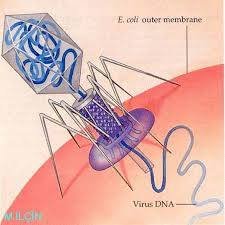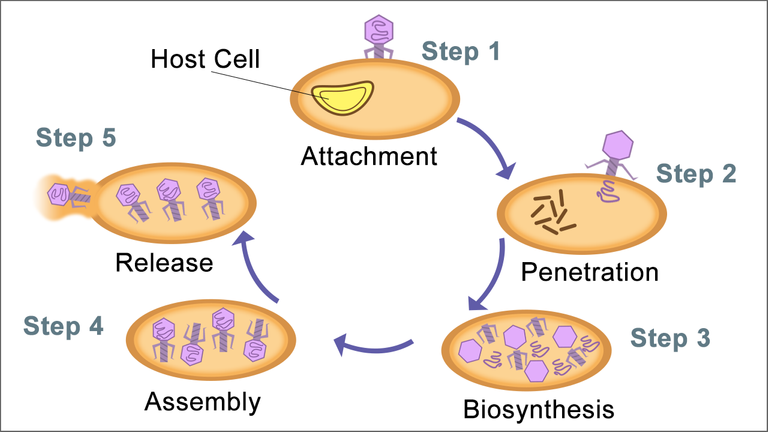Bacteriophage.
Systematic Position:
Division: Vira
Subdivision: Deoxyvira
Class: Deoxybinala
Order: Virales
Sub-order: Phagineae
Name: Bacteriophage
Bacteriphages are the viruses of bacteria.They were discovered by FrederickW.Twort in England in 1915 and by Felix D’Herelle at the institute of Pasture in paris in 1917.The term becteriophage was given by D’Herelle which means bacteria eater. Bacterial viruses are widely distributed in nature. Phages exist almost in all bacteria.
Structure and Composition

As we know, virsus are basically composed of nucleic acid and protein.The bacterioghages also composed of nucleic acid coat which is surrounded by protein coat, the capsid made up of sub-units called as capsomeres.
Ultrastructure of T-even Phage
The shape of T-even phage is tadpole.Head and tail are its main parts.
Head
The head is in the form of a pyramidal, hexagonal prism.It is composed pf proteinaceous membrane enclosing a core of doubled-stranded viral DNA.
Tail
The tail is elongated and cylindrical which is attached to one end of the head.The tail is composed of four components.
It is central helical hollow tube or core through which viral DNA passes during infection.The core is covered by a proteinaceous sheath.The sheath is attached to a thin disc or coller at the end of head.The distal end of the sheath is connected to a hexagonal basal plate, which is of complex structure.The plate has a pin at every corner.The plate is connected to a six long thin tail fiber which are used during attachment to tha wall of host cell.
Types of Bacteriophage
There are two main types of bacterial viruses which are given below:
1.Lytic or virulent Phages
The phages which destroy the host bacterial cell after infection are known as lytic or virulent phages.They reproduce inside the host cell and produce a large number of viruses.The host cell bursts for the release of new phages which infect the other bacterial cells.This is called lytic cycle.
- Temperate or Avirulent Phages
The phages which do not harm and destroy the host bacterial cells are known as temperate or avirulent phages.The viral nucleic acid id injected to the host cell and then it is replicates itself in the host cell without damaging the host bacterial cells for many generations.However, sometimes the temperate phages may become virulent at some subsequent generation and lyse the host cells which called lysogenic cycle.
Life cycle of Bacteriophage
There are two types of life cycle in bacteriophage virus which are lytic cycle or lysogenic cycle.
Lytic life cycle

In lytic life cycle the viral DNA does not located within the host DNA.It is free floating molecule within the bacterial cell not within the host DNA.It replicates itself and lysis of the bacterial cell occur.Then thenew generation attack new bacterium cell.
There are following step are involve during the life cycle of a lytic bacteriophage, - Adsorption.
The first one step in the life cycle is adsorption of the virus to the cell wall of the host bacterial cell.The virion attaches itself to the host through the ionic bonds and at specific sites. - Penetration.
The second step is known as penetration.The tip of the viral tail is attached to the receptor sites on the bacterial cell surface.The tail fiber bend to anchor the tail pins and base plate to cell surface.The tail sheath contract forcing the hollow fiber tail into the cell.An enzyme is involve for the penetration which is called lysozyme.Then the viral nucleic acid is injected into the host cell.The protein coat remain outside the cell.
3.How viral DNA take the metabolism control of the host cell.
The third step is that the viral DNA takes the control of the cell metabolism and direct the bacterium for the viral enzymes using ribosomes of the host.It breaks down the host DNA and the viral mRNA is formed which directs the synthesis of viral proteins that assemble heads, tail and fiber.The viral DNA replicates and its number increases.This phase of life cycle is called transcription.
4.Assembly of Bacteriophage.
When the synthesis of structural protein and nucleic acid is taking place, new phages begin to assemble.About 25 minutes after initial infection, some 200 new bacteriophages have been assembled.
5.Release of Bacteriophage.
In this step the host cell bursts, releasing the new phages to attack on the other bacterial cells.then the cycle begins again.The time taken from infection until lysis is called latent period.
Lysogeny or Lysogenic life cycle of Bacteriophage.
In the lytic life cycle not all infections of bacterial cells by phages terminate in lysis.In some cases an entirely different relationship is known as lysogeny, meaning having potential for lysis, may develop between the virus and its bacterial host.
This life cycle is different from the lytic life cycle. In this cycle the viral DNA of the temperate phage, instead taking over the function of the cell’s genes, is incorporated into the host DNA and becomes a prophage eeeeeeeein the bacterial chromosomes, acting as a gene.In lysogeny the viral DNA is transmitted to each daughter cell through all generation.Sometimes, however, for unknown reason, the viral DNA is removed from the host chromosomes and the lytic cycle occurs.This phenomenon is known as spontaneous induction.This is due to induction of ultraviolet radiations or by exposure of some chemicals.
Example.
Lysogeny has been studied best in coliphage lambda.It has been observed that the multiplication of phage is repressed inside the infected cell, because the genes responsible for the phage multiplication and lysis are switched off.The phage possesses a gene that codes for repressor protein which make the cell resistant to lysis initiated either by the prophage or another lytic virus. When the phage lambda is exposed to ultraviolet light this introduces the synthesis of a protein in the host cell.This possibly induces lysis.

✅ @mameen745, I gave you an upvote on your post! Please give me a follow and I will give you a follow in return and possible future votes!
Thank you in advance!
lol still no vote